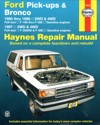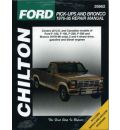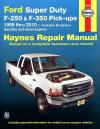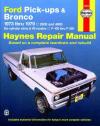
Ford Pick-ups and Bronco 1980 to 1996 F100 F150 F250 F350 Haynes repair manual NEW Get other Ford repair manuals here US Ford Pick-ups Bronco 1980 – 1996 Haynes Owners Service Repair Manual covers: #9679; Ford F100 F150 F250 F350 and BroncoEngines Covered: #9679; 300 cu in (4.9 litre) inline 6-cylinder #9679; 232 cu in V6 #9679; 255 302 (5.0 litre) #9679; 351 (5.8 litre) #9679; 400 460 cu in (7.5 litre) V8 engines.Does not include Diesel Engine or Super Duty Vehicle Information.Contents: #9679; Introductory Pages About this Manual; Introduction to the Ford Pick-ups Bronco; Vehicle Identification Numbers; Buying Parts; Maintenance Techniques Tools and Working Facilities; Booster Battery (jump) starting; Jacking and Towing; Automotive Chemicals and Lubricants; Conversion Factors; Safety First!; Troubleshooting #9679; Tune-up and Routine Maintenance #9679; In-Line 6 Cylinder Engine #9679; V8 Engines #9679; General Engine Overhaul Procedures #9679; Cooling Heating and Air Conditioning #9679; Fuel and Exhaust Sy
Ford Pick-ups and Bronco Petrol and Diesel 1976 – 1986 F100 F150 F250 F350 Chiltons repair manual NEW Get other Ford Bronco repair manuals here US Ford Pick-Ups Bronco Petrol Diesel 1976 – 1986 Chilton Owners Service Repair Manual covers 1976 to 1986 Ford F-100 F-150 F-250 and F-350 pickup trucks and 1978-1986 Bronco 2WD and 4WD models gasoline and diesel. U.S. and Canadian editions. Engines covered: #9679; Ford 3.8 litre V6 (232 cid) #9679; Ford 4.2 litre V8 (255 cid) #9679; Ford 4.9 litre inline 6-cylinder (300 cid) #9679; Ford 5.0 litre V8 (302 cid) #9679; Ford 5.8 litre V8 (351 cid) #9679; Ford 5.9 litre V8 (360 cid) #9679; Ford 6.5 litre V8 (390 cid) #9679; Ford 6.6 litre V8 (400 cid) #9679; Ford 6.9 V Diesel V8 #9679; Ford 7.5 litre V8 (460 cid) Contents: #9679; Introduction: About This Manual; Introduction; Vehicle Identification Numbers; Maintenance Techniques Tools And Working Facilities; Buying Parts; Jacking And Towing; Booster Battery (Jump) Starting; Conversion Factors; Automotive Chemicals And Lubricants; Safety First!; Troubleshooting #
USA manual Ford Super Duty F-250 F-350 Pick-ups Petrol Diesel 1999 – 2010 Haynes Owners Service Repair Manual covers: Ford Super Duty F-250 F-350 Excursion models.Please note: This manual DOES NOT include F-450 or F550 models.Engines covered: 5.4 litre (329ci) SOHC V8 petrol 6.0 litre (365ci) V8 turbo-diesel 6.8 litre (415ci) SOHC V10 petrol 7.3 litre (444ci) V8 turbo-dieselPlease note that this manual DOES NOT cover the 4.2 litre Turbo Diesel 6 Cylinder.Contents: Introductory Pages About this Manual; Introduction to the Ford Super Duty F-250 F-350 Pick-ups; Vehicle Identification Numbers; Buying Parts; Maintenance Techniques Tools and Working Facilities; Booster Battery (jump) starting; Jacking and Towing; Automotive Chemicals and Lubricants; Conversion Factors; Safety First!; Troubleshooting Tune-up and Routine Maintenance 5.4 litre V8 Petrol Engine 6.8 litre V10 Petrol Engine 6.0 litre 6.4 litre 7.3 litre.png)
Ford Pick-Ups Bronco 1987 – 1996 Chilton Owners Service Repair Manual Covers covers all US and Canadian models 2-wheel drive and 4×4 powered by petrol and diesel engine including: Ford F-150 Ford F-250 Ford F-350 Ford F-Super Duty Ford Bronco Ford Chassis Cab Ford Commercial Chassis Ford F-Series Motor Home ChassisContents: Introduction: About This Manual; Introduction; Vehicle Identification Numbers; Maintenance Techniques Tools And Working Facilities; Buying Parts; Jacking And Towing; Booster Battery (Jump) Starting; Conversion Factors; Automotive Chemicals And Lubricants; Safety First!; Troubleshooting Tune-Up And Routine Maintenance Engine And Overhaul Procedures Cooling Heating And Air-Conditioning Systems Fuel And Exhaust Systems Engine Electrical Systems Emissions Control Systems Transmission Brakes Suspension And Steering Systems Body Chassis Electrical System Wiring DiagramsChilton repair manuals can save you money on maintenance and repair bills. Step-by-step procedures and illustrations guide you through every job from basic maintenance and troub
Ford Pick-ups and Bronco 1980 to 1996 F100 F150 F250 F350 Haynes repair manual NEW Get other Ford repair manuals here US Ford Pick-ups Bronco 1980 – 1996 Haynes Owners Service Repair Manual covers: #9679; Ford F100 F150 F250 F350 and BroncoEngines Covered: #9679; 300 cu in (4.9 litre) inline 6-cylinder #9679; 232 cu in V6 #9679; 255 302 (5.0 litre) #9679; 351 (5.8 litre) #9679; 400 460 cu in (7.5 litre) V8 engines.Does not include Diesel Engine or Super Duty Vehicle Information.Contents: #9679; Introductory Pages About this Manual; Introduction to the Ford Pick-ups Bronco; Vehicle Identification Numbers; Buying Parts; Maintenance Techniques Tools and Working Facilities; Booster Battery (jump) starting; Jacking and Towing; Automotive Chemicals and Lubricants; Conversion Factors; Safety First!; Troubleshooting #9679; Tune-up and Routine Maintenance #9679; In-Line 6 Cylinder Engine #9679; V8 Engines #9679; General Engine Overhaul Procedures #9679; Cooling Heating and Air Conditioning #9.png)
Get other Ford repair manuals hereFord F150 Pick-Ups 2004 – 2014 Haynes Owners Service Repair Manual covers: Ford F-150 full-size pickup trucks 2WD and 4WD 2004 to 2006 USA models.Please Note: This manual DOES NOT include F-150 Heritage Lightning F-250 Super Duty or diesel models.Engines Covered: 4.2 litre (256ci) OHV V6 petrol 4.6 litre (281ci) SOHC V8 petrol 5.4 litre (330ci) SOHC V8 petrolInside this manual you will find: Routine Maintenance tune-up procedures engine repair cooling and heating air-conditioning fuel and exhaust emissions control ignition brakes suspension and steering electrical systems and wiring diagrams.Haynes repair manuals can save you money on maintenance and repair bills. Step-by-step procedures and illustrations guide you through every job from basic maintenance and troubleshooting to complete teardown rebuild.
Ford Pick-ups and Bronco 1973 to 1979 F100 to F350 Haynes repair manual NEW Get other Ford repair manuals here Ford Pick-Ups Bronco 1973 – 1979 Haynes Owners Service Repair Manual covers: All full size Pick-Ups F-100 to F-350 and Bronco 6 Cylinder and V8 engines 1973 – 1979240 and 300 cubic inch six-cylinder inline and 302 351 360 390 400 and 460 cubic inch V8 petrol engines are covered with 3- and 4-speed manual and 3-speed automatic transmissions and rear or four wheel drive. NOTE: The vehicles described are those marketed in North America and might differ from those sold in Australia Engines covered are: 240 cu in OHV in-line 6-cylinder300 cu in OHV in-line 6-cylinder302 cu in OHV V8351 cu in OHV V8360 cu in OHV V8390 cu in OHV V8400 cu in OHV V84
Ford Pick-ups and Bronco 1973 to 1979 F100 to F350 Haynes repair manual NEW Get other Ford repair manuals here Ford Pick-Ups Bronco 1973 – 1979 Haynes Owners Service Repair Manual covers: All full size Pick-Ups F-100 to F-350 and Bronco 6 Cylinder and V8 engines 1973 – 1979240 and 300 cubic inch six-cylinder inline and 302 351 360 390 400 and 460 cubic inch V8 petrol engines are covered with 3- and 4-speed manual and 3-speed automatic transmissions and rear or four wheel drive. NOTE: The vehicles described are those marketed in North America and might differ from those sold in Australia Engines covered are: 240 cu in OHV in-line 6-cylinder300 cu in OHV in-line 6-cylinder302 cu in OHV V8351 cu in OHV V8360 cu in OHV V8390 cu in OHV V8400 cu in OHV V8460 cu in OHV V8 .Inside this manual you will find: Routine Maintenance tune-up procedures engine repair cooling and heating air-conditioning fuel and exhaust emissions control ignition brakes suspension and steering electrical systems and wiring diagrams.Haynes repair manuals can save you money on maintenance an
Ford Pick-ups and Bronco Petrol and Diesel 1976 – 1986 F100 F150 F250 F350 Chiltons repair manual NEW Get other Ford Bronco repair manuals here US Ford Pick-Ups Bronco Petrol Diesel 1976 – 1986 Chilton Owners Service Repair Manual covers 1976 to 1986 Ford F-100 F-150 F-250 and F-350 pickup trucks and 1978-1986 Bronco 2WD and 4WD models gasoline and diesel. U.S. and Canadian editions. Engines covered: #9679; Ford 3.8 litre V6 (232 cid) #9679; Ford 4.2 litre V8 (255 cid) #9679; Ford 4.9 litre inline 6-cylinder (300 cid) #9679; Ford 5.0 litre V8 (302 cid) #9679; Ford 5.8 litre V8 (351 cid) #9679; Ford 5.9 litre V8 (360 cid) #9679; Ford 6.5 litre V8 (390 cid) #9679; Ford 6.6 litre V8 (400 cid) #9679; Ford 6.9 V Diesel V8 #9679; Ford 7.5 litre V8 (460 cid) Contents: #9679; Introduction: About This Manual; Introduction; Vehicle Identification Numbers; Maintenance Techniques Tools And Working Facilities; Buying Parts; Jacking And Towing; Booster Battery (Jump) Starting; Conversion Factors; Automotive Chemicals And Lubricants; Safety First!; Troubleshooting #9679; Tune-Up And Routine Maintenan
Keywords: Ford Pick ups Bronco 1980 1996 Haynes Service Repair Manual
Keywords: Ford Pick-ups and Bronco (1976-86)
Keywords: Ford Super Duty F-250 F-350 Pick ups 1999-2010
Keywords: Ford Ute Pick-ups and Bronco 1987-96 Chiltons
Keywords: Ford Pick ups Bronco 1980 1996 Haynes Service Repair Manual
Keywords: Ford F150 Pick Ups 2004-2014 Haynes Service Repair Manual
Keywords: Ford Pick Ups Bronco 1973 1979 Haynes Service Repair Manual
Keywords: Ford Pick Ups Bronco 1973 1979 Haynes Service Repair Manual
Keywords: Ford Pick-ups and Bronco (1976-86)
The Ford Bronco is a sport utility car that was prepared from 1966 to 1996, with five distinct generations. Broncos can be split into two areas: early Broncos (1966–77) and full-size Broncos (1978–96).
The Bronco was introduced in 1966 as a competitor to the small four-wheel-drive compact SUVs this type of once the Jeep CJ-5 and worldwide Harvester Scout, and built on the personal system. A major redesign in 1978 moved the Bronco to a bigger dimensions, and it was built making use of a shortened Ford F-Series truck chassis to compete aided by the similarly adapted Chevrolet K5 Blazer.
The full-size Broncos and the successor Expedition had been manufactured at Ford’s Michigan Truck Plant in Wayne, Michigan.
The Bronco permanently entered preferred customs on June 17, 1994, as a processed 1992 unit purchased and powered by Al Cowlings with O. J. Simpson, whom had been wanted for the murders of his ex-wife and the lady buddy, attempted to elude the Los Angeles authorities section in a low-speed chase. With an approximate television audience of 95 million, the celebration was described "once the many famous ride on American shores since Paul Revere’s".
The initial Bronco had been an ORV (Off-Road car), intended to compete mainly with Jeep CJ designs and the worldwide Harvester Scout. The Bronco’s little size riding on a 92-inch (2,337 mm) wheelbase created it preferred for off-roading and some different utilizes, but impractical for this type of things as towing. The Bronco was Ford’s initial compact SUV, and Ford’s compact and midsize SUV niche would be taken by the compact pickup based Ford Bronco II (1984–1990), Ford Explorer (1991–present) and the Ford Escape (2001–present).
The move behind the Bronco started with Ford item employer Donald N. Frey, who furthermore conceived of the Ford Mustang; and similarly, Lee Iacocca moved the idea through into manufacturing. In a lot of means, the Bronco was a much more original concept than the Mustang; while the Mustang was based on the Ford Falcon, the Bronco got a frame, suspension, and figure that had been not shared with any some other vehicle.
The Bronco had been designed under engineer Paul G. Axelrad. Although the axles and brakes were sourced from the Ford F-100 four wheel drive pickup truck, the front axle was located by radius arms (from the frame near the back of the transmission ahead to the axle) and a lateral track bar, creating the utilization of coil springs that gave the Bronco a 34-foot (10.4 m) twisting round, long wheel travel, and an anti-dive geometry that has been valuable for snowplowing. The back suspension had been a lot more mainstream, with leaf springs in a typical Hotchkiss artwork. A shift-on the-fly Dana Corp. transfer situation and securing hubs had been standard, and heavy-duty suspension was a solution.
The first system was the Ford 170 cu in (2.8 L) straight-6, changed with trusted valve lifters, a 6-US-quart (6 l) oil pan, heavy-duty fuel pump, oil-bath air cleaner, and a carburetor with a float pan compensated against tilting.
Styling was subordinated to simplicity and economy, now all glass was flat, bumpers were straight-forward C-sections, the frame was a straight-forward box-section ladder, and the basic left and right door skins are identical except for mounting holes.
The early Broncos were offered in wagon, the ever preferred halfcab, and less popular roadster designs. Roadster was dropped early and the play set, which afterwards turned into a model line, was added.
The starting point price tag was US$2,194, but the long solution listing included front bucket seats, a back bench seat, a tachometer, and a CB radio, along with practical objects such as a tow pub, an auxiliary gas tank, an electric power take-off, a snowplow, a winch, and a posthole digger. Aftermarket accessories included campers, overdrive units, and the normal range of rims, tires, chassis, and engine parts for increased show.
The Bronco available really in its first 12 months (23,776 models produced) and then remained in second spot after the CJ-5 until the advancement of the full-sized Chevrolet Blazer in 1969. Poor a dedicated little SUV platform, the Blazer was based around their existing full size pickup that has been a larger and a lot more effective vehicle, offering greater luxurious, comfort and area. The more time choice opt-in list included a programmed transmission and power directing, and so got wider attract. Ford countered by enlarging the optional V8 engine from 289 cu in (4.7 L) and 200 hp (150 kW) to 302 cu in (4.9 L) and 205 horsepower (153 kW), but this nevertheless would never match the Blazer’s optional 350 cu in (5.7 L) and 255 hp (190 kW) (horsepower numbers tend to be before horsepower ranks changed in the early to mid-1970s.)
In 1973, the 170 was changed by a 200 cu in (3.3 L) right six, power steering and programmed transmissions happened to be made optional, and revenues spiked to 26,300. By then, however, Blazer earnings were dual those of the Bronco, and global Harvester had observed the light and come out with the Scout II that was more in the Blazer lessons. By 1974, the bigger and more comfortable vehicles such once the Jeep Cherokee (SJ) made more sense for the mean driver than the more rustically-oriented Bronco. The low revenues of the Bronco (230,800 over twelve years) failed to enable a large resources for upgrades, and it stayed basically unchanged until the advancement of the larger, a lot more Blazer-like second generation Bronco in 1978. Production of the initial model dropped (14,546 models) in the last year, 1977.
In 1965, racecar builder Bill Stroppe assembled a professionals of Broncos for long-distance off-road competition for Ford. Partnering with Ford’s frequently favored race professionals Holman-Moody, the Stroppe/Holman/Moody (SHM) Broncos proceeded to dominate the Mint 400, Baja 500, and Mexican 1000 (which had been later known as the Baja 1000). In 1969 SHM once more entered a team of six Broncos in the Baja 1000. In 1971, a "Baja Bronco" plan partially derived from Stroppe’s artwork was granted in the Ford showrooms, showcasing quick-ratio power directing, automatic transmission, fender flares covering Gates Commando wheels, a roll pub, fortified bumpers, a cushioned directing wheel, and distinctive red, white, blue, and black paint. However, at a cost of US$5,566 versus the traditional V8 Bronco cost of $3,665, merely 650 had been available over the following four many years.
In 1966, a Bronco "witty automobile" built by Doug Nash for the quarter mile dragstrip ran "erratic" with a few minimal 8-second times, but sidelined by sanctioning organizations whenever pickups and aluminum structures happened to be outlawed.
The redesign of the Bronco in 1978 was based on a shortened full sized F-100 pickup. It had a removable peak and forward folding rear bench seat, similar to the contending Blazer. It shared many chassis, drivetrain, and figure components. The entire front clip is indistinguishable from their complete dimensions trucks for those many years. In 1978 Broncos had been equipped with round headlights, with the exception of the Ranger XLT trim model. In 1979 all Broncos happened to be accepted with square sealed ray headlights. Ford launched the redesign in 1972, codenamed Project Short-Horn, but introduction had been delayed by concerns over the mid-1970s fuel crisis. The base engine had been a 351 cu in (5.75 L), with an optional 400 cu in (6.6 L). A Ford 9" rear axle and a Dana 44 front axle happened to be accepted, with leaf spring rear suspension and coil sprung, laterally stabilized position.
The 1978 and 1979 Broncos included an option for either full-time four-wheel drive utilizing the New Process 203 business powered move case or, a lot more usually, part-time four-wheel drive with the New Process 205 accessories powered move case.
The 1978 and 1979 Broncos additionally merged the back glass hatch and tailgate of the predecessor into a single unit that allowed the rear glass panel to retract completely into the tailgate by utilization of an electrical engine controlled by a key-operated switch on the tailgate’s external or a dash-mounted control change. This did result in trouble for some customers, as the weight of the glass panel usually overheated the motor, occasionally subjecting it to failing. Customers additionally complained that the retractable glass panel authorized drinking water to get inside and brought about the tailgate to rust prematurely from the lower up. However, this design prevailed until the Bronco’s end in 1996.
1979 watched the improvement of a catalytic converter, and other different emissions controls equipment.
The Bronco received a major redesign for 1980, coinciding with the F-Series. The unique Bronco had been smaller, and got cosmetic changes along with powertrain, suspension and some other odds and finishes. Many notably, the real time front axle was replaced by a Dana 44 Twin grip Beam (TTB) arrange in the front end for an independent front suspension. The TTB is actually a crossbreed of a true independent front suspension and a secure front axle, with a "secure" axle that pivots around the differential and makes use of coil springs alternatively of leaf springs. The TTB system granted a higher level of controls and comfort both on and off track, but sacrificed wheel travel, and is truly notorious to be difficult to maintain aligned whenever larger than stock tires tend to be used.
With a lighter Bronco and fuel economy in mind, Ford offered a 300 cu in (4.9 L) straight six once the base motor. Though this system emerged with increased torque than the 302 cu in (4.95 L) V8 and equal to the 351 cu in (5.75 L) V8 (until the maximum Output model), it had been limited by a 1-bbl carburetor and restrictive single-out exhaust manifolds. Electronic emissions equipment added in 1984 further decreased the power of the inline six. Ford used up their remaining stock of 351M engines before turning over to the 351W in mid-model year 1982. A "Extreme Output" type of the 351W was an option in 1984 and carried on actually into the 1987 model year until the introduction of gas shot. Output had been 210 horsepower (157 kW) at 4000 rpm vs the traditional 2-bbl 351W which created 156 hp (116 kW) at 4000 rpm. The 302 was the very first system to obtain electronic fuel-injection, starting in the 1985 unit year, along with a four-speed automatic overdrive transmission. The Eddie Bauer trim plan started in 1985 as actually. From 1980 to 1984, some Broncos got moving topper windows.
Cosmetically, Ford came home to their choose of the "blue oval" icon on the front of a slightly redesigned grille, and removed the "F O R D" letters from the hood in 1982. Power Low Mount Swing Lock mirrors had been initial offered in 1981. Classic square mirrors and the optional electric power low mount swing lock mirrors are discontinued in 1986.
In 1987, the body and drivetrain of the fullsize Bronco changed, as it was even based on the F-Series. The new aero body type reflected a bigger redesign of many Ford vehicles for the unique model spring. By 1988, all Broncos happened to be staying sold with electronic fuel shot (very first introduced in 1985 with the 302). In 1991, a 25th Silver Anniversary Edition had been available showcasing specialized badges, Currant Red paint and a gray and red leather rooms. A Nite edition, similar to that in the F-Series, was furthermore available in 1991 and 1992, the 91’s choose to be rarer. All Broncos had been built during the Michigan Truck Plant in Wayne, Michigan in the exact same line as the F-150.
The 5-speed M5OD-R2 transmission was added as a solution for 302-powered Broncos in 1987. 1988-89 351W trucks received a c6 transmission. For 1990, the electronically-controlled E4OD programmed overdrive emerged standard on the 351W, and 300. The AOD was mated because of the 302 from 1987-1990. By 1991 All engines received the E4OD.
A V8 engine and programmed transmission had been accepted in Eddie Bauer, Nite, and Silver Anniversary trucks.
The Bronco, along with the F-Series, was updated for 1992. The new Bronco was redesigned with safety in mind, incorporating front crumple zones, rear shoulder seat belts, a third braking system illumination embedded in the detachable peak, and after 1994, driver-side airbags. Because of the taillight and shoulder belts staying security gear integrated into the top, the top was no longer legally detachable (though it was even physically possible) and all writing within the owners guides that got earlier revealed simple tips to eliminate the peak was removed. Torx "tamper proof" bolts, which necessary a specialized tool, had been used in place of accepted hex head bolts to secure the peak in place.
Aesthetic outdoor and interior changes supplied a sweeping front end and an unique dash. Electric power mirrors happened to be once again granted in 1992 and in 1996 the Bronco was the first vehicle to combine turn signal lights in the mirrors.
Maroon and pink leather seats were first offered in 1992 through the end of manufacturing. 1994-1996 XLTs and Eddie Bauers need the rear cargo panels slotted for a cargo cover and net. The 302 moved bulk Air run (MAF) in 1994. The 351 moved MAF in 1995 in California. The rest of the 351s went MAF in 1996 along, with OBD2 on both the 302 and 351. 94-95 351 blocks are roller prepared, and both 302 and 351w 1996s are roller blocks. 1995 Eddie Bauers produce a vented front bumper. 1996 XLTs and Eddie Bauers produce a vented position bumper. All 1994-1996 Eddie Bauers need an overhead console. Some 1994-1996 XLTs or Eddie Bauers have lit sun visors and a dimming rear observe mirror. 94-96 monochrome trucks tend to be XLT athletics. These people were offered in black color, red, and processed. In 1992 Ford offered a 1992 Nite edition bronco. All black, with gray indoors. Another restricted edition colors granted regarding the mid-1990s XLTs was a two-tone illumination teal green and white outdoor with a charcoal gray inside. Merely about 600 of the teal and white two-tone had been produced each year.
In mid-1996, Ford formally made the choice to discontinue the Bronco. On June 12, 1996, the final Bronco ever built rolled away the assembly line at Michigan’s Ford Truck Plant. The final Bronco had been escorted by Jeff Trapp’s 1970 Ford Bronco during a Drive-Off Ceremony. It had been replaced by the Ford Expedition that addressed a marketplace that preferred 4-passenger doors, because well as to compete with GM’s Chevrolet Tahoe and heavier Chevrolet Suburban.
At the 2004 North American worldwide Car Show, a Bronco concept car was introduced. Some qualities of the concept vehicle, really once the box-like roof line, close wheelbase, and the round headlamps are really features connected with the Early Bronco, but this concept auto furthermore had a 2.0 L intercooled turbodiesel I4 engine and a six-speed manual transmission. It would have been built on the Escape system. As the Ford CD2 system was dropped on the 2013 Ford Escape, it is extremely unlikely that this Bronco concept will see production.
Check the spring holes the same .
But but play up to different cylinders .